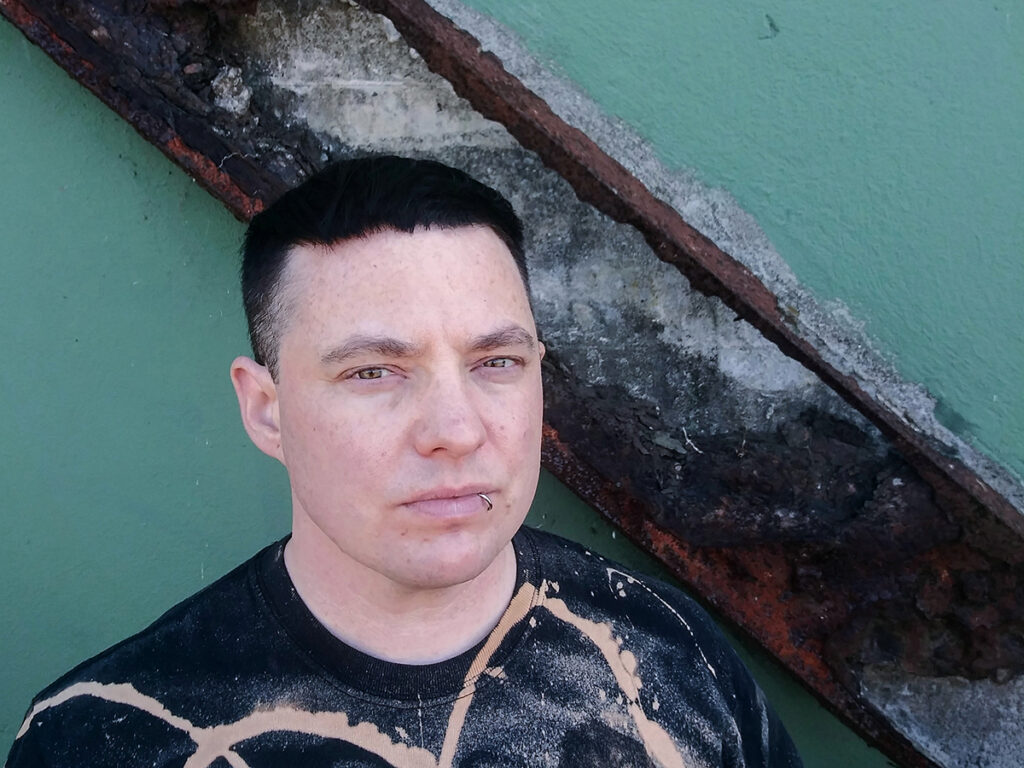To The Moon! Mann Stearns Award Aiding Amalya’s Experimental Doc About Flight
For Malic Amalya’s new film about the mythology of flight, the Visual & Media Arts Assistant Professor will travel to watch a SpaceX launch with the help of a grant from Emerson.
Amalya is one of two faculty recipients of this year’s Norman and Irma Mann Stearns Distinguished Faculty Award.

The other recipient, Associate Professor Adam Franklin-Lyons, wants to know how people in the Middle Ages communicated with each other across distances. With the help of the grant from Emerson, he’ll travel to Spain to gather 360-degree photos from strategic lookouts.
Established by the late Dr. Norman Stearns and Emerson alumna Irma Mann Stearns ’67, this award honors a full-time tenured or tenure-track faculty member in recognition of outstanding scholarly or creative achievement. A $3,000 award is presented annually to at least one applicant. Funding may be used to enhance an ongoing project or for the development of a new scholarly or creative endeavor. Travel is strongly encouraged to be a part of the project activity.
Amalya’s new film, New Earth, a 16mm experimental documentary, is currently in development. He discussed the film, along with why birds are being renamed, the connection of cultural values to flight, the Space Race, and more.
How is the Norman and Irma Mann Stearns grant going to help you?
Amalya: I am thrilled to receive the Norman and Irma Mann Stearns grant because it enables me to travel for my new film New Earth. Currently in development, New Earth is an experimental documentary that investigates colonialist ideologies through the theme of flight, both inside and outside the Earth’s atmosphere. This motif branches into three distinct but interconnected sections: outer space and the goal of multiplanetary-living, the history and impact of the Transportation Security Administration (also known as TSA), and human classification of birds and insects, bird and insect decline, and ecological collapse.
My first stop is Merrit Island in Florida, where NASA’s Kennedy Space Center is located. I will plan my trip around a SpaceX rocket launch. Official viewings are open to the public and relatively affordable – about $75. In addition to filming the rocket launch, I’ll also film in and around the space center.
Merritt Island is also home to a National Wildlife Refuge, so I’ll film local birds and insects there. In the area, I’ll be on the lookout for everything and anything that relates to flight.

How does this project help you be a better professor at Emerson?
Amalya: As an experimental filmmaker, any chance to push my creative process is going to have a positive impact on my syllabus development and teaching. With this particular film I’m specifically using Emerson’s Arriflex and the Aaton Super 16mm cameras, which I haven’t had a lot of practice using in my creative work. I’m intentionally using these cameras so that I can become better at instructing students on how to use them.
What makes the cameras different?
Amalya: The Bolex is the 16mm camera we use in VM230: Introduction to Analog Filmmaking. The body of the camera is small and can only hold 100′ of film, which is approximately 3 minutes. Additionally, Bolex cameras have windup motors that can only run for 30 seconds. Because of the windup motor, they can’t keep in sync with a sound recording.
Both the Arriflex and Aaton 16mm cameras are more heavy duty. They can hold 400′ of film, approximately 12 minutes. They both have crystal sync motors that run on external batteries, which makes them capable of keeping sync with sound.
Why did you want to make this documentary?
Amalya: New Earth is the third film in my series of 16mm mythologies. Each of the films focus on specific tourist attractions in the U.S. and examine the cultural metaphors, values, doctrines, and practices created at these sites.
From ancient myths to contemporary science fiction, the heavens have occupied our collective imagination. The US Space Race with the Soviet Union tied our national identity to NASA and the Apollo 11 moon landing in 1969. And now, 55 years later, we have civilians traveling commercially into space.
Space tourism officially began in 2001, when Dennis Tito spent $20 million to travel to the International Space Station. From 2001 to 2020, there were eight commercial trips by one company. Since 2021, there has been a proliferation in commercial space travel and private space tourism companies: 13 flights in three years with five different companies.
My current research is asking, why was the US so invested in the Space Race? How was the Space Race tied to military development? How did the Space Race influence our national identity? And how has the relationship between space travel and our national identity changed during the past 75 years?
My second research question is on the impact of space travel. There’s this excitement surrounding the idea of multi-planetary living. However, the reality is we currently live in a perfect ecosystem that we’re putting in jeopardy in order to travel to barren worlds where we can’t naturally breathe or grow food. What specifically is the impact of rocket launches on the Earth’s atmosphere? What resources are being directed towards space travel? How could those resources be redirected to improve life on earth?
A third question is about the formation and impact of TSA. TSA was signed into law by President George W. Bush in November 2001, two months after the 9/11 attacks. After 9/11, there was a complete shift in airport security. For years there was an “Orange Alert” threat level – a constant “high alert” warning of terrorist attacks. In 2010, full body scanners were introduced, depicting each passenger naked in high contrast, black and white images. What level of safety have we achieved and what rights have we given up in the name of safety?
Who are you interviewing for the film?
Amalya: New Earth is an experimental documentary. Unlike most mainstream documentaries that rely on interviews with experts or people who have first hand experience, there will be no traditional interview footage included in the film.
I am planning to interview people who have experienced discrimination by TSA and structural barriers to flying by airlines. For example, a close friend of mine uses a power chair that has been custom designed for their body. In fact, they consider their power chair an extension of their body. First of all, no commercial airline has accessible seating for them to fly in their power chair. After flying in an inaccessible seat, the baggage handlers completely destroyed their power chair.
I want to interview people with disabilities who have had similar experiences; people of color who have experienced racial profiling by TSA; people, particularly women, who have been sexually assaulted by TSA; and transgender and gender non-conforming passengers who have had invasive pat-downs because their bodies are illegible to body scanners and TSA agents.
Instead of including traditional interviews, my idea is to craft a voiceover track that includes details from specific stories told by individuals, which will be interjected by multiple voices critiquing systematic oppression, which will be spoken in unison. Visually, I will film the participants in high contrast, black and white film, and in circular movements that mirror the body scanners.
When will you be filming the movie?
Amalya: I will film the bulk of New Earth this upcoming fall during my pre-tenure leave, and I will continue filming in the winter and spring of 2025
What would be an example of a cultural metaphor as it relates to the topic of the film?
Amalya: The National Audubon Society is a non-profit organization that works to protect birds and their habitat. Named after the ornithologist, John James Audubon, they were formed in 1905 and there are currently 500 local chapters across the United States. Unfortunately, in addition to being a talented bird painter, John James Audubon was a white colonizer and slaveholder, and he advocated for white supremacy. Recently, the society voted to keep their name but 26 local chapters have removed “Audobon” from their name. For example, in March 2023, the NYC Audubon became the New York City Bird Alliance.
Similarly, the American Ornithological Society will be renaming 152 bird species that were originally named after humans, many of which are white people, like Audubon, who have ties to racist practices and ideologies.
These original names reflect the original, racist values held within the field of ornithology. By changing the chapter names and the bird names, these organizations are acknowledging the history and impact of white supremacy and breaking with those values. Making symbolic changes – in conjunction with concrete change, such as access to resources – is vital to ending racism.
What else would you like people to know about the film, yourself, Emerson, or anything else?
Amalya: New Earth is not a typical documentary. You can probably tell by all the different directions the film is going in. There could be whole feature-length documentaries about each of these topics. My interest is not in providing a complete case study of each topic. Rather, my interest is in how these topics are interconnected.
Despite having these three distinct sections, New Earth will not have a three-section structure. Instead, through the use of “bridges,” the scenes will intersperse and ricochet off of each other. In conventional film editing, bridges create smooth transitions by using overlapping sounds or intermediate B-roll. In my experimental, collage-like editing style, I use bridges to merge and conflate scenes.
This amalgamation of images and sounds creates aesthetic, emotional, and – most importantly – ideological connections between seemingly distinct scenes. Rather than having individual scenes that build a narrative arc or a cohesive argument, my non-linear structure allows for complexities to arise without smoothing over contradictions. Furthermore, this fine arts approach to documentary formally reflects an intersectional analysis.
Categories